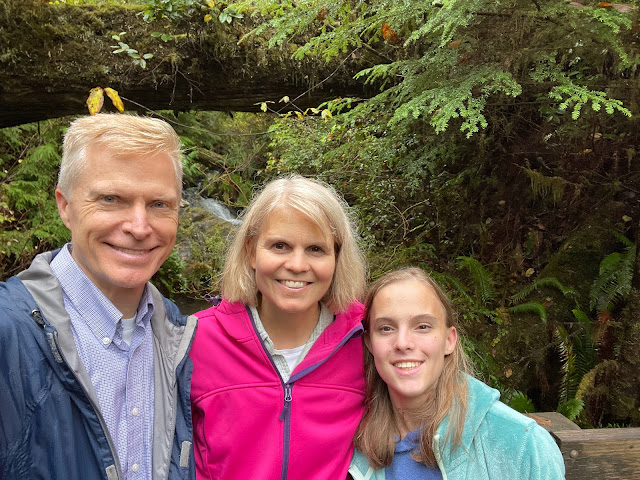We recently came back from visiting Washington where my husband grew up and where a few of his relatives still live. At the beginning of the trip we visited the Olympic National Forest near Lake Quinault. This was a magical place for me since I had never visited any place like it before.
Here was what it looked like when we first showed up.
Fortunately it stopped raining shortly after we arrived and we headed out on the trails. The trails were not muddy. They were gentle trails--it felt easy to hike at sea level coming from our higher altitude.This temperate rain forest averages over 130 inches of rain per year. For comparison, where we live averages 16 inches of water per year. Their summers are fairly dry and then it rains a lot in the other seasons.
Thanks to all that life-giving water, there was life growing everywhere.
There were also dead trees everywhere. Hurricanes sometimes come up there and the trees with more shallow roots go down. Because they get so much rain, the trees don't have to put down deep roots. Wind blown trees account for 80% of the downed trees.
The downed trees also host tons of plants.
Fungi:
It felt like a place out of The Hobbit:
We saw several waterfalls which are little hard to photograph with all of the trees:
The yellow stuff is some kind of fungus. Different types of fungi were growing everywhere:
Another banana slug:
After we checked into our motel (lodging were quite limited), we did a short hike to the largest Sitka Spruce in the world:
We wanted to see the other largest trees of other varieties in the area but they required long hikes to get to them. For dinner, we ate at the Salmon House--eating options were very limited. It was good salmon and we had a nice view of Lake Quinault. Earlier, it was very foggy.
The next morning we did a little more hiking. Since we went in the offseason, there were very few people on the trails. This tree in the next picture looks very unusual because it grew out of a nurse log. A nurse log is a fallen tree out of which a new tree grows. Eventually the rest of the nurse log rots away, and the roots of the new tree are exposed as in this picture. The nurse log provides both moisture in the dry summer and lots of nutrients to the new tree.
These temperate rain forests have a huge amount of biomass. All the life-giving water hosts an incredible amount of life.
The rain forest takes a couple of hours to get to from the Seattle Airport but it was well worth the drive.

































Comments
Post a Comment